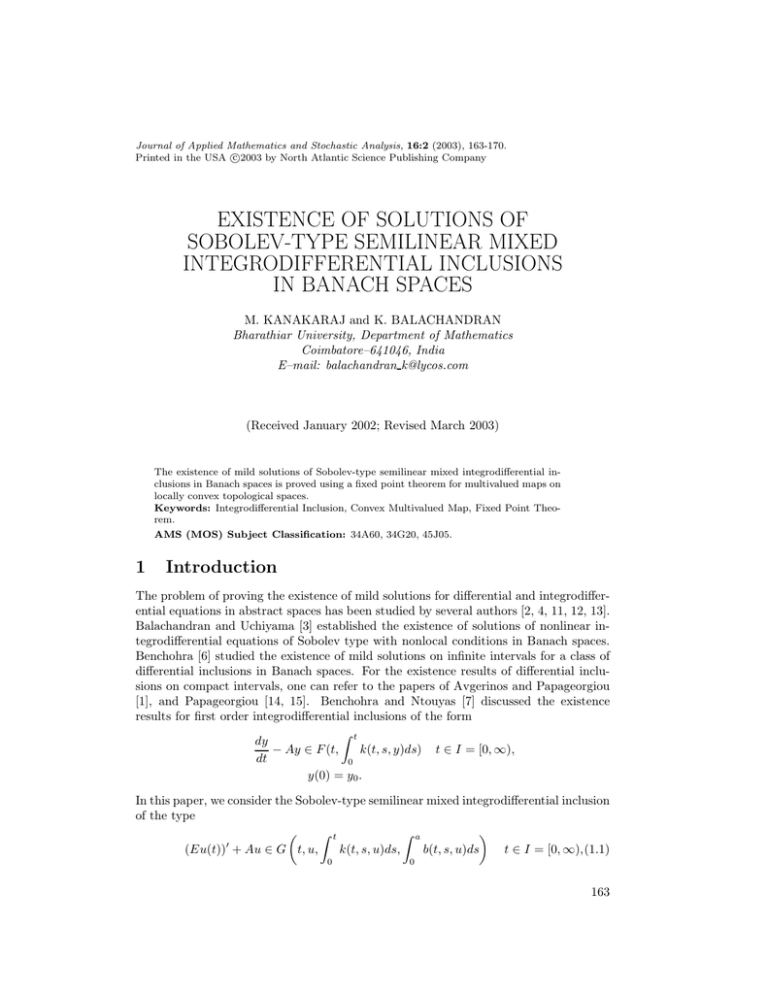Document 10909291
advertisement

Journal of Applied Mathematics and Stochastic Analysis, 16:2 (2003), 163-170.
c
Printed in the USA 2003
by North Atlantic Science Publishing Company
EXISTENCE OF SOLUTIONS OF
SOBOLEV-TYPE SEMILINEAR MIXED
INTEGRODIFFERENTIAL INCLUSIONS
IN BANACH SPACES
M. KANAKARAJ and K. BALACHANDRAN
Bharathiar University, Department of Mathematics
Coimbatore–641046, India
E–mail: balachandran k@lycos.com
(Received January 2002; Revised March 2003)
The existence of mild solutions of Sobolev-type semilinear mixed integrodifferential inclusions in Banach spaces is proved using a fixed point theorem for multivalued maps on
locally convex topological spaces.
Keywords: Integrodifferential Inclusion, Convex Multivalued Map, Fixed Point Theorem.
AMS (MOS) Subject Classification: 34A60, 34G20, 45J05.
1
Introduction
The problem of proving the existence of mild solutions for differential and integrodifferential equations in abstract spaces has been studied by several authors [2, 4, 11, 12, 13].
Balachandran and Uchiyama [3] established the existence of solutions of nonlinear integrodifferential equations of Sobolev type with nonlocal conditions in Banach spaces.
Benchohra [6] studied the existence of mild solutions on infinite intervals for a class of
differential inclusions in Banach spaces. For the existence results of differential inclusions on compact intervals, one can refer to the papers of Avgerinos and Papageorgiou
[1], and Papageorgiou [14, 15]. Benchohra and Ntouyas [7] discussed the existence
results for first order integrodifferential inclusions of the form
Z t
dy
− Ay ∈ F (t,
k(t, s, y)ds) t ∈ I = [0, ∞),
dt
0
y(0) = y0 .
In this paper, we consider the Sobolev-type semilinear mixed integrodifferential inclusion
of the type
Z t
Z a
0
(Eu(t)) + Au ∈ G t, u,
k(t, s, u)ds,
b(t, s, u)ds
t ∈ I = [0, ∞),(1.1)
0
0
163
164
M. KANAKARAJ and K. BALACHANDRAN
u(0) = u0 ,
where G : I × X × X × X → 2Y is a bounded, closed, convex, multivalued map
k : ∆ × X → X, b : ∆ × X → X, where ∆ = {(t, s) ∈ I × I; t ≥ s}, u0 ∈ X, a is a real
constant, X, Y are real Banach spaces with norms k.k and |.|, respectively. Our method
is to reduce the problem (1.1) to a fixed point problem of a suitable multivalued map
in the Frechet space C(I, X) and we make use of a fixed point theorem due to Ma [10]
for multivalued maps in locally convex topological spaces.
2
Preliminaries
In this section we introduce the notations, definitions and preliminary facts from multivalued analysis which are used in this paper. Im is the compact interval [0, m](m ∈ N ).
C(I, X) is the linear metric Frechet space of continuous functions from I into X with
the metric
d(u, z) =
∞
X
2−m ku − zkm
for each u, z ∈ C(I, X),
1 + ku − zkm
m=0
where kukm = sup{ku(t)k : t ∈ Im }. B(X) denotes the Banach space of bounded linear
operators from X into X. A measurable function u : I → X is Bochner integrable if and
only if |u| is Lebesgue integrable. Let L1 (I, X) denote the Banach space of continuous
functions u : I → X which are Bochner integrable normed by
Z ∞
kukL1 =
ku(t)kdt,
0
and Ur is a neighbourhood of 0 in C(I, X) defined by
Ur = {u ∈ C(I, X) : kukm ≤ r}
for each m ∈ N. The convergence in C(I, X) is the uniform convergence on compact
intervals, that is, uj → u in C(I, X) if and only if for each m ∈ N, kuj − ukm → 0 in
C(Im , X) as j → ∞. BCC(X) denotes the set of all nonempty bounded, closed, and
convex subsets of X.
valued if G(x) is convex(closed)
A multivalued map G : X → 2X is convex(closed) [
for all x ∈ X. G is bounded on bounded sets if G(B) =
G(x) is bounded in X for any
x∈B
bounded set B of X (that is, sup {sup{kuk : u ∈ G(x)}} < ∞). G is called upper semi
x∈B
continuous on X if for each x0 ∈ X the set G(x0 ) is a nonempty, closed subset of X, and
if for each open subset B of X containing G(x0 ), there exists an open neighbourhood A
of x0 such that G(A) ⊆ B. G is said to be completely continuous if G(B) is relatively
compact for every bounded subset B ⊆ X. If the multivalued map G is completely
continuous with nonempty compact values, then G is upper semicontinuous if and only
if G has a closed graph (that is, xn → x0 , un → u0 , un ∈ Gxn imply u0 ∈ Gx0 ).
We assume the following conditions:
(i) The operator A : D(A) ⊂ X → Y and E : D(E) ⊂ X → Y satisfy the following
conditions
Existence of Solutions of Sobolev-Type
165
[C1 ] A and E are closed linear operators.
[C2 ] D(E) ⊂ D(A) and E is bijective.
[C3 ] E −1 : Y → D(E) is continuous.
[C4 ] The resolvent R(λ, −AE −1 ) is a compact operator for some λ ∈ ρ(−AE −1 )
and resolvent set of −AE −1 .
Conditions [C1 ], [C2 ], and the closed graph theorem imply the boundedness of the linear
operator AE −1 : Y → Y .
(ii) G : I × X × X × X → BCC(Y ) is measurable with respect to t for each u ∈ X,
upper semi continuous with respect to u for each t ∈ I, and for each u ∈ C(I, X)
the set
Z t
Z a
SG,u = {g ∈ L1 (I; R) : g(t) ∈ G(t, u,
k(t, s, u)ds,
b(t, s, u)ds)
0
0
for a.e t ∈ I} is nonempty.
(iii) There exist functions p(t), q(t) ∈ C(I; R) such that
Z a
Z t
k(t, s, u)ds| ≤ p(t)kuk and |
b(t, s, u)ds| ≤ q(t)kukfor a.e t, s ∈ I, u ∈ X.
|
0
0
(iv) There exists a function α(t) ∈ L1 (I; R+ ) such that
kG(t, u, v, w)k ≤ α(t)Ω(kuk + kvk + kwk)
for a.e t ∈ I, u ∈ X, where Ω : R+ → (0, ∞) is continuous increasing function
satisfying Ω(p(t)x + q(t)y) ≤ p(t)Ω(x) + q(t)Ω(y) and
Z m
Z ∞
du
M
α(s)(1 + p(s) + q(s))ds <
Ω(u)
0
c
for each m ∈ N, where c = kE −1 kM |Eu0 | and M = max{kT (t)k; t ∈ I}.
(v) For each neighbourhood Ur of 0, u ∈ Ur and t ∈ I, the set
Z t
{E −1 T (t)Eu0 +
E −1 T (t − s)g(s)ds, g ∈ SG,u }
0
is relatively compact.
Definition 2.1: A continuous function u(t) of the integral inclusion
Z t
Z s
Z a
−1
−1
E T (t − s)G s, u,
k(s, τ, u(τ ))dτ,
b(s, τ, u(τ ))dτ ds
u(t) ∈ E T (t)Eu0 +
0
0
0
is called a mild solution of (1.1) on I.
Lemma 2.1: [9]. Let I be a compact real interval and let X be a Banach space. Let
G be a multivalued map satisfying (i) and let Γ be a linear continuous mapping from
L1 (I, X) to C(I, X). Then the operator
Γ ◦ SG : C(I, X) → X, (Γ ◦ SG )(y) = Γ(SG,y )
166
M. KANAKARAJ and K. BALACHANDRAN
is a closed graph operator in C(I, X) × C(I, X).
Lemma 2.2: [10]. Let X be a locally convex space. Let N : X → X be a compact,
convex valued, upper semicontinuous, multivalued map such that there exists a closed
neighbourhood Ur of 0 for which N (Ur ) is a relatively compact set for each r ∈ N . If
the set ζ = {y ∈ X : λy ∈ N (y)} for some λ > 1 is bounded, then N has a fixed point.
Remark: [9]. If dimX<∞ and I is a compact real interval, then for each u ∈
C(I, X), SG,u is nonempty.
Lemma 2.3: [16]. Let S(t) be a uniformly continuous semigroup and let A be its
infinitesimal generator. If the resolvent set R(λ : A) of A is compact for every λ ∈ ρ(A),
then S(t) is a compact semigroup.
From the above fact, −AE −1 generates a compact semigroup T (t) in Y . Thus,
max |T (t)| is finite and so denote M = max |T (t)|.
t∈I
3
t∈I
Main Result
Theorem 3.1: If the assumptions (i)–(v) are satisfied, then the initial value problem
(1.1) has at least one mild solution on I.
Proof: A solution to (1.1) is a fixed point for the multivalued map
N : C(I, X) → 2C(I,X) defined by
N (u) = {h ∈ C(I, X) : h(t) = E −1 T (t)Eu0 +
Z
t
E −1 T (t − s)g(s)ds, g ∈ SG,u },
0
where
SG,u = {g ∈ L1 (I, X) : g(t) ∈ G(t, u,
Z
0
t
k(t, s, u(s))ds,
Z
a
b(t, s, u(s))ds)
0
for a.e t ∈ I}.
First we shall prove N (u) is convex for each u ∈ C(I, X). Let h1 , h2 ∈ N (u), then
there exist g1 , g2 ∈ SG,u such that
hi (t) = E
−1
T (t)Eu0 +
Z
t
E −1 T (t − s)gi (s)ds, i = 1, 2, t ∈ I
0
Let 0 ≤ k1 ≤ 1, then for each t ∈ I we have
Z t
(k1 h1 + (1 − k1 )h2 )t = E −1 T (t)Eu0 +
E −1 T (t − s)(k1 g1 (s) + (1 − k1 )g2 (s))ds.
0
Since SG,u is convex, thus kh1 + (1 − k)h2 ∈ N (u). Hence, N (u) is convex for each
u ∈ C(I, X).
Let Ur = {u ∈ C(I, X); kuk ≤ r} be a neighbourhood of 0 in C(I, X) and u ∈ Ur .
Then for each h ∈ N (u) there exists g ∈ SG,u such that for t ∈ I, we have
Z
t
kE −1 kkT (t − s)kkg(s)kds
Z t
−1
−1
α(s)Ω(kuk + p(t)kuk + q(t)kuk)ds
kE kM |Eu0 | + kE kM
kh(t)k ≤ kE
−1
kkT (t)k|Eu0 | +
0
≤
0
Existence of Solutions of Sobolev-Type
≤
≤
kE
−1
kM |Eu0 | + kE
−1
kM
kE −1 kM |Eu0 | + kE −1 kM
Z
Z
167
t
α(s)(Ω(kuk) + p(t)Ω(kuk) + q(t)Ω(kuk))ds
0
t
α(s)(1 + p(s) + q(s))Ω(kuk)ds
0
≤
kE −1 kM |Eu0 | + kE −1 kM kαkL1 (Im ) k(1 + p(s) + q(s))k sup Ω(kuk)
u∈Ur
Hence, N (Ur ) is bounded in C(I, X) for each r ∈ N . Next we shall prove N (Ur ) is an
equicontinuous set in C(I, X) for each r ∈ N . Let t1 , t2 ∈ Im with t1 < t2 . Then for all
h ∈ N (u) with u ∈ Ur , we have
kh(t1 ) − h(t2 )k
≤ kE −1 kk(T (t2 ) − T (t1 ))Eu0 k
Z t2
−1
+ kE kk
(T (t2 − s) − T (t1 − s))g(u)dsk
0
Z t2
T (t1 − s)g(u)dsk
+ kE −1 kk
t1
≤
kE −1 kk(T (t2 ) − T (t1 ))Eu0 k
Z t2
−1
+ kE kk
(T (t2 − s) − T (t1 − s))g(u)dsk
0
Z m
−1
+ M (t2 − t1 )kE k
kg(s)kds.
0
Hence, by the Ascoli-Arzela Theorem, we conclude that N : C(I, X) → 2C(I,X) is
a completely continuous multivalued map. Next we shall prove that N has a closed
graph. Let un → u∗ , hn ∈ N (un ) and hn → h0 , then we shall prove that h0 ∈ N (u∗ ).
Here, hn ∈ N (un ) means that there exists gn ∈ SG,un such that
Z t
hn (t) = E −1 T (t)Eu0 +
E −1 T (t − s)gn (s)ds, t ∈ I.
0
We must also prove that there exists g0 ∈ SG,u such that
Z t
−1
h0 (t) = E T (t)Eu0 +
E −1 T (t − s)g0 (s)ds,
t ∈ J.
(3.1)
0
To prove the above, we use the fact that hn → h0 ; and hn − E −1 T (t)Eu0 ∈ Γ(SG,u ),
where
Z
t
E −1 T (t − s)g(s)ds,
(Γg)(t) =
t ∈ I.
0
Consider the functions un , hn − E −1 T (t)Eu0 and gn defined on the interval [k, k + 1] for
any k ∈ N ∪ {0}. Then using Lemma 2.1, we can conclude (3.1) is true on the compact
interval [k, k + 1]. That is,
Z t
[h0 (t)][k,k+1] = E −1 T (t)Eu0 +
E −1 T (t − s)g0k (s)ds
0
Rt
RT
for a suitable L1 -selection g0k of G(t, u, 0 k(t, s, u)ds, 0 b(t, s, u)ds) on the interval
[k, k + 1]. Let g0 (t) = g0k (t) for t ∈ [k, k + 1). Then g0 is an L1 -selection and (3.1)
168
M. KANAKARAJ and K. BALACHANDRAN
will satisfied. Clearly we have k(hn − E −1 T (t)Eu0 ) − (h0 − E −1 T (t)Eu0 )k∞ → 0 as
n → ∞. Consider for all k ∈ N ∪ {0}, the mapping
k
y → SG,y
k
: C([k, k + 1], X) → L1 ([k, k + 1], X),
SG
Z t
Z
= {g ∈ L1 ([k, k + 1], X) : g(t) ∈ G(t, u,
k(t, s, u)ds,
0
a
b(t, s, u)ds)
0
for a.e t ∈ [k, k + 1]}.
Now we consider the linear continuous operators
Γk : L1 ([k, k + 1], X) → C([k, k + 1], X),
Z t
g → Γk (g)(t) =
E −1 T (t − s)g(s)ds.
0
From Lemma 2.1 it follows that
Moreover, we have
k
Γ k ◦ SG
is a closed graph operator for all k ∈ N ∪ {0}.
k
)
(hn (t) − E −1 T (t)Eu0 )|[k,k+1] ∈ Γk (SG,u
n
k
and un → u∗ . From Lemma 2.1, we have (h0 (t) − E −1 T (t)Eu0 )|[k,k+1] ∈ Γk (SG,u
),
∗
(h0 (t) − E
−1
T (t)Eu0 )|[k,k+1] =
Z
t
k
E −1 T (t − s)g0k (s)dsfor someg0k ∈ SG,u
.
∗
0
Hence, the function g0 defined on I by g0 (t) = g0k (t) for t ∈ [k, k + 1] is in SG,u∗ .
Therefore, N (Ur ) is relatively compact for each r ∈ N where N is upper semicontinuous
with convex closed values. Finally we prove the set ζ = {u ∈ C(I, X); λu ∈ N u}, for
some λ > 1, is bounded.
Let λu = N u for some λ > 1. Then there exists g ∈ SG,u such that
Z t
E −1 T (t − s)g(s)ds, t ∈ I,
u(t) = λ−1 E −1 T (t)Eu0 + λ−1
0
Z t
−1
−1
α(s)(1 + p(s) + q(s))Ω(kuk)ds.
ku(t)k ≤ kE kM |Eu0 | + kE kM
0
Rt
Let v(t) = kE −1 kM |Eu0 | + kE −1 kM 0 α(s)(1 + p(s) + q(s))Ω(kuk)ds. Then we have
v(0) = kE −1 kM kEu0 k = c and ku(t)k ≤ v(t), t ∈ Im . Using the increasing character of
Ω we get
v 0 (t) ≤
kE −1 kM α(t)(1 + p(t) + q(t))Ω(v(t)), t ∈ Im .
The above proves that for each t ∈ Im ,
Z v(t)
Z m
Z ∞
du
du
−1
≤ kE kM
.
α(s)(1 + p(s) + q(s))ds <
Ω(u)
Ω(u)
v(0)
0
0
The above inequality implies that there exists a constant M0 such that v(t) ≤ M0 , t ∈
Im , and hence that kuk∞ ≤ M0 where M0 depends on m and on the functions α, p, Ω.
Hence, ζ is bounded. Thus by Lemma 2.2, N has a fixed point that is a mild solution
of (1.1).
Existence of Solutions of Sobolev-Type
4
169
Nonlocal Initial Conditions
Several authors have studied the nonlocal Cauchy problem in abstract spaces [2, 3, 4,
11, 12, 13]. The importance of nonlocal conditions is discussed in [4, 5]. In this section
we consider a first order Sobolev-type, semilinear, mixed, integrodifferential inclusion
(1.1) with the nonlocal initial condition
u(0) + f (u) = u0
(4.1)
In addition to the five assumptions in Section 2, we also assume the following.
(vi) f : C(I, X) → X is a continuous function, and there exists a constant L > 0 such
that kf (u)k ≤ L for each u ∈ X.
Rm
R ∞ du
where c1 = kE −1 kM |Eu0 | +
(vii) kE −1 kM 0 α(s)(1 + p(s) + q(s))ds < c1 Ω(u)
−1
LkE kM |Eu0 |.
(viii) For each neighbourhood Ur of 0, u ∈ Ur and t ∈ I, the set {E −1 T (t)Eu0 −
Rt
E −1 T (t)Ef (u) + 0 E −1 T (t − s)g(s)ds, g ∈ SG,u } is relatively compact.
Definition 4.1: A continuous function u(t) of the integral inclusion
u(t) ∈ E −1 T (t)Eu0 − E −1 T (t)Ef (u)
Z t
Z s
Z
+
E −1 T (t − s)G s, u,
k(s, τ, u(τ ))dτ,
0
0
a
b(s, τ, u(τ ))dτ ds
0
is called a mild solution of (1.1)-(4.1) on I.
Theorem 4.1: If the assumptions (i)–(iii), (vi)–(viii) are satisfied, then the nonlocal initial value problem (1.1)–(4.1) has at least one mild solution on I.
The proof of Theorem 4.1 is similar to Theorem 3.1 and hence, is omitted.
References
[1] Avgerinos, E.P. and Papageorgiou, N.S., On quasilinear evolution inclusions, Glas.
Mat.Ser. III 28:48 (1993), 35–52.
[2] Balachandran, K. and Chandrasekaran, M., The nonlocal Cauchy problem for semilinear integrodifferential equations with deviating argument, Proc. Edinburgh Math.Soc. 44
(2001), 63–70.
[3] Balachandran, K. and Uchiyama, K., Existence of solutions of nonlinear integrodifferential
equations of Sobolev type with nonlocal condition in Banach spaces, Proc. Indian Acad.
Sci. Math. Sci. 110 (2000), 225–232.
[4] Balachandran, K. and Uchiyama, K., Existence of solutions of quasilinear integrodifferential equations with nonlocal condition, Tokyo J. Math. 23 (2000), 203–210.
[5] Byszewski, L., Theorems about the existence and uniqueness of solutions of a semilinear
evolution nonlocal Cauchy problem, J. Math. Anal. Appl. 162 (1992), 495–505.
[6] Benchohra, M., Existence of mild solutions on infinite intervals to first order initial value
problems for a class of differential inclusions in Banach spaces, Disc. Math. and Differ.
Inclus. 19 (1999), 111–121.
170
M. KANAKARAJ and K. BALACHANDRAN
[7] Benchohra, M. and Ntouyas, S.K., An Existence result on noncompact intervals to first
order integrodifferential inclusions in Banach spaces, Libertas Mathematica 20 (2000),
71–78.
[8] Corduneanu, C., Integral Equations and Applications, Cambridge Univ.Press, New York
1990.
[9] Lasota, A. and Opial, Z., An application of the Kakutani-Ky-Fan theorem in the theory of
ordinary differential equations, Bull. Acad. Polon. Sci. Ser. Sci. Math. Astronom. Phys.
13 (1965), 781–786.
[10] Ma, T.W., Topological degrees for set-valued compact vector fields in locally convex spaces,
Dissertationess Math. 92 (1972), 1–43.
[11] Ntouyas, S.K. and Tsamatos, P.Ch., Global existence for second order semilinear ordinary
and delay integrodifferential equations with nonlocal conditions, Applic. Anal. 67 (1997),
245–257.
[12] Ntouyas, S.K. and Tsamatos, P.Ch., Global existence for semilinear evolution integrodifferential equations with delay and nonlocal conditions, Applic. Anal. 64 (1997), 99–105.
[13] Ntouyas, S.K., Global existence results for certain second order delay integrodifferential
equations with nonlocal conditions, Dynam. Systems Appl. 7 (1998), 415–426.
[14] Papageorgiou, N.S., Mild solutions of semilinear evolution inclusions, Indian J. Pure Appl.
Math. 26 (1995), 189–216.
[15] Papageorgiou, N.S., Boundary value problems for evolution inclusions, Comment. Math.
Univ. Carol. 29 (1988), 355–363.
[16] Pazy, A., Semigroups of Linear Operators and Applications to Partial Differential Equations, Springer-Verlag, New York 1983.





